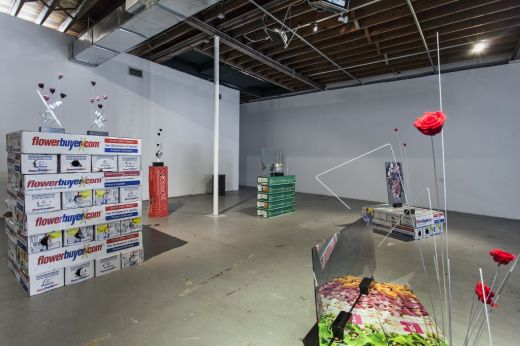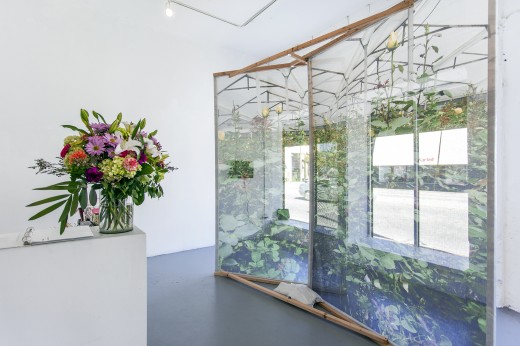- Americana (Pérez Art Museum Miami: December 4, 2013 – May 1, 2014)

- Barnacles on the Boat: Notions of Literature at the Key West Literary Seminar
Virginia Poundstone, BOG-MIA
Laura Randall

Virginia Poundstone, Installation view of BOG-MIA, 2014. Ginger Photography Inc., courtesy of Locust Projects.
The acronyms in the title represent the airports in Bogota and Miami, two points on a vast global network for angiosperms, and, likewise, the arrangement of BOG-MIA inside Locust Projects supports this larger narrative. The first video installation is a recording of a Colombian worker picking flowers from a row of plants in a greenhouse, and a long vinyl screen printed with a photograph of dead, discarded flowers hangs above the corridor towards the second gallery. On the first wall of the second gallery, large video projections show the packaging plants where most commercial flowers are processed. The second gallery is filled with sculptures more in tune with her larger body of work: small, geometric, aluminum sculptures with real, artificially preserved roses. The small part aluminum, granite, and floral arrangements rest on stacks of the cardboard boxes the commercial flowers are packed in.
The process of collecting, selecting, shipping, and arranging flowers for sale is a thriving international industry. The history of use-value and subsequent exchange value of flowers is not unlike the long discourse that has grown around art. Poundstone’s work certainly taps into this economic history, as well as the flower’s place in art history as a common symbol of vanitas. The theme of vanitas, enlisted in the arts as a symbol to reaffirm our notion of what is earthly and ephemeral, is challenged by Poundstone’s roses. The roses in her sculptures have undergone a technique in the flower industry of rapid dehydration, thus creating an eternalized, semi-artificial flower. The transformation of the value of a commodity, illustrated through the transformation of the flower in industry (Tulip Mania being one popular example), is all the more challenging visually.

Virginia Poundstone, Installation view of BOG-MIA, 2014. Ginger Photography Inc., courtesy of Locust Projects.









